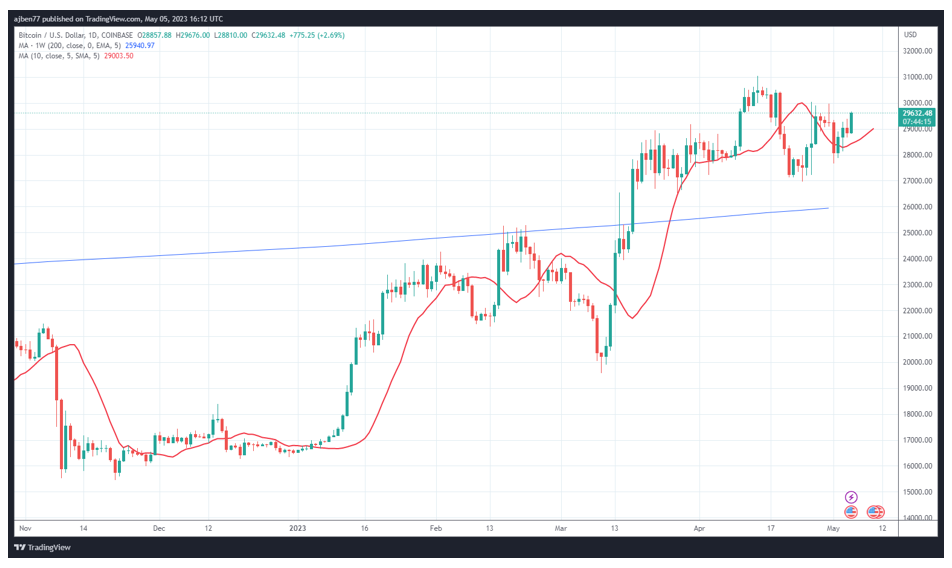Bank Collapses Fuel Crypto’s Rise
 |
| By Juan Villaverde & Alex Benfield |
According to a recent Federal Reserve report, Silicon Valley Bank failed because of a “textbook case of mismanagement.”
Its downfall was blamed on its senior leadership and board of directors … but certainly not the Fed’s supervisory failures.
Just another outlier, the Fed says. Nothing to see here.
Coincidentally, on the same day, First Republic met its demise. It was seized by the Federal Deposit Insurance Corporation and sold to JPMorgan Chase (JPM).
Is this another outlier? Or the start of a concerning pattern?
The Fed wouldn't dare suggest that its own policies might contribute to these failures. Instead, it blames mismanagement, weak business models and even social media.
But the Fed's interest-rate policy? Nah, couldn't be that!
As banks continue to topple left and right, depositors are moving their cash to money market funds instead. These funds lend to the Fed via the Reverse Repo Facility.
With $2.3 trillion earning close to 5% interest, it's an offer you can't refuse. Traditional finance can't compete, as the yield curve on government securities is inverted.
The Fed is outbidding the U.S. Treasury, and savers are flocking.
How does the Fed afford such high yields? Simple! It can print the money.
Record losses since last year? No biggie, just an accounting curiosity.
Traders and speculators, however, bet rates will come down soon. Actual government bonds — only slightly riskier than deposits at the Fed — ironically pay much lower yields.
Here's the issue: The high yields the Fed pays are draining cash from the real economy.
Regional banks can't compete for deposits. They need to find higher-yielding investments, but they can't just demand higher yields from their existing fixed-rate mortgage contracts.
Instead, they have to wait for mortgages to mature and try to replace them with higher-yielding ones, which could take ages.
Enter the "monetary policy" of the 2020s: Fed officials hoover up deposits, causing banks to fail. Instead of taking accountability, the Fed blames social media, the internet and bad risk managers.
Why can’t the Fed’s Bank Term Funding Program help protect regional banks? Well, only government securities are acceptable collateral for BTFP loans. Mortgages don’t qualify.
You see, First Republic had just $16 billion in government securities — a pittance compared to the $100 billion in outflows it recently faced.
So, this mess can end in one of two ways:
1. More banks fail until something big enough blows up, forcing the Fed to slash interest rates and print money.
2. Or the Fed expands the BTFP to include assets held by regional banks, firing up the printing press to purchase their stuff.
Either way, more printing is coming … which should send crypto asset prices soaring again.
Overall, bank failures will persist until the printers-in-chief take action. What the Fed does with interest rates is irrelevant.
The only thing that matters to us as investors is whether central banks print money and expand their balance sheets.
We saw this in March, with crypto assets nearly skyrocketing.
In the end, markets will get what they want: More money printing. More asset purchases. More currency debasement to erase past sins.
So, as the Fed keeps pointing fingers and pretending everything's just fine, keep an eye on the bigger picture. With every new bank failure and policy misstep, we will be one step closer to a very different financial future.
First Republic brings our count of bank failures to four in just the past two months. And this number is likely to grow before this problem is over.
Now let’s turn to Alex’s breakdown of how this is playing out in the crypto market in real time.
Investors Emerge from Hibernation Despite Banking Woes
Excitingly, the market is showing renewed signs of life as investors emerge from their bear market hibernation.
Memecoins have gone berserk this month, with newcomer Pepe (PEPE, Not Yet Rated) rising from the crypto underworld to become the 39th largest cryptocurrency by market cap in less than a month.
In fact, Pepe has had a jaw-dropping 1,200% surge over the past week alone! This demonstrates the market’s appetite for high-risk assets.
And to learn more about those risks, I suggest taking a look at what a few industry experts had to say in an interview with my colleague Jurica Dujmovic.
The resurgence of memecoins is a testament to the enduring spirit and potential of crypto bull markets, ready to be unleashed once again.
As enthusiasm for these coins increases, it's possible that the excitement will spill over into other areas of the market, driving up demand and prices.
So, this memecoin frenzy could translate into bullish sentiment for altcoins and the broader crypto market.
However, we are going to have to wait a bit before we get too excited about bull markets. This is because we don’t expect things to really kick off until 2024.
But that doesn’t mean that this year won’t be exciting.
If Bitcoin can flip $30,000 into support, there might be another rally in the near future. And Bitcoin is inching closer to that level, as it is up 2.5% on the day and is currently trading right around $29,600.
If BTC can clear $30,000 and close above that level over the weekend, there may be some fireworks in store for us next week.
Meanwhile, Ethereum (ETH, “B”) is also having quite the day as it is knocking on the door of that important $2,000 level.
Currently up 6% on the day, ETH may be heating up due to the recent action in the memecoin space. For now, we are looking for ETH to flip $2,000 into support and make a run at its recent high of $2,150.

Click here to see full-sized image.
This year is likely to be a neutral year, meaning that rallies will be followed by corrections as the market bobs up and down.
What this means for you is that you should remember to take profits when you’ve got the opportunity.
Currently, we are looking out for one more rally in the month of May before we expect our first large correction of the year. Things are about to be fun again.
But if timing the market isn’t a strategy you’re keen on pursuing, my colleague Chris Coney has an interesting alternative.
Using a few key tools, he’s developed a strategy that allows him to go for impressive yield in the world of DeFi in any market environment. Bear, neutral or bull, doesn’t matter. In each, he’s been able to earn yields that beat what’s available in TradFi.
In fact, his most conservative position with the least amount of risk exposure is currently yielding roughly 18% APY using stablecoin deposits. That’s double the yield from junk bonds … without the risk of damage to his principal.
Chris is revealing this strategy in his upcoming Superyield Conference, to be held this Tuesday, May 9 at 2 p.m. And it’s entirely free to attend for our loyal Weiss Ratings subscribers like you.
Just be sure to save your seat now.
And in the meantime, have a great weekend and keep your eyes off the charts. We’ve got that covered for you.
Best,
Juan & Alex


